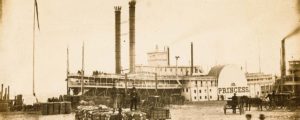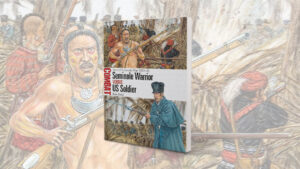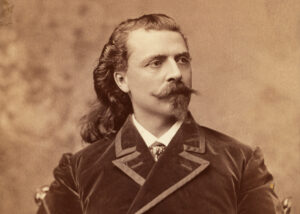The improbable life and times of Henry Francisco.
Henry Francisco was no stranger to the battlefield when the American Revolution broke out virtually on his doorstep in the winter of 1776–77. Given an imminent British invasion of upper New York, the Continental Army intensified its recruiting efforts in the region during those frigid winter months, and Francisco, like many of his neighbors, answered the call. But something about this old man set him apart from even his most seasoned compatriots: At the time of his enlistment, Francisco was 91 years old.
Evidence suggests that Francisco, who ran a tavern in Fort Edward during the war, was not only the oldest person to enlist in the U.S. Army, but also one of history’s oldest humans. At the time of his death in 1820, he was said to be 134 years old and, perhaps even more incredible, a veteran of more than a century’s worth of armed conflict. From his younger days as a drummer under the Duke of Marlborough to his time in the French and Indian War, to his later skirmishes at Saratoga, Francisco’s astonishing life is interwoven with the fabric of history—as both witness and combatant.
Francisco’s lifetime travels read like a historical roadmap. The son of Huguenots, he was reportedly born between May 31 and June 11, 1686, in a small French village, during a brief respite from the religious persecution directed by Louis XIV. Earlier, Henry’s father had fled to Holland, where he married a Dutch woman. The two returned to France shortly before Henry’s birth, but within five years the family once again fled, ultimately emigrating to England. It was there Henry’s adventures would begin —but it was far from where they would end.
According to Francisco’s statements to interviewers, made late in his life, he first served as a drummer boy in Queen Anne’s army and witnessed many of the British-French clashes on the continent. Next, he settled in colonial New York, where in middle age he took up arms again, this time for the French and Indian War, and was reportedly present for Braddock’s Defeat in 1755. Yet despite the heavy toll all those years and battles had taken, when duty called again in 1776, military records confirm one of Francisco’s most startling claims: After nearly a century spent living and fighting on two continents, in 1777 Francisco took to the field as he’d done so many times before.
One day in the autumn of 1819, Benjamin Silliman had a few hours to kill as he waited for a steamboat bound for St. John’s, Canada. Silliman, a Yale scholar and one of the most esteemed scientists of his day, was traveling through the northeast and planning to publish his memoirs from the voyage. Along the way, he learned of Francisco’s uncanny claims and decided to make a side trip to visit the man. According to Silliman, at the time Francisco was living two miles from Whitehall, N.Y., on the Salem Road to Albany.
Silliman’s published journal, Remarks Made on a Short Tour, Between Hartford and Quebec, in the Autumn of 1819, reads: “We rode out to see (probably) the oldest man in America. He believes himself to be 134 years old, and the country around believe him to be of this great age. When we arrived at his residence (a plain farmer’s house, not painted, rather out of repair and much open to the wind) he was upstairs, at his daily work of spooling and winding yarn. This occupation is auxiliary to that of his wife, who is a weaver, and although more than 80 years old, she weaves 6 yards a day, and the old man can supply her with more yarn than she can weave.”
Silliman expected a man of Francisco’s reputed age to be quite feeble, so he offered to climb the stairs to visit. Much to his surprise, Francisco instead soon began to descend the stairs all on his own, “walking somewhat stooping and supported by a staff, but with less apparent inconvenience than most persons exhibit at 85 or 90.” He described Francisco as middle in stature and rather slender and delicate, yet “he stoops but little, even when unsupported.”
Overall, Silliman was quite taken with the old man’s appearance: “[Francisco’s] complexion is very fair and delicate, and his expression bright, cheerful and intelligent; his features are handsome, and considering that they have endured through one-third part of a second century, they are regular, comely and wonderfully undisfigured by the hand of time; his eyes are of a lively blue; his profile is Grecian and very fine.”
The professor then noted what was perhaps Francisco’s most distinguishing feature: “His head is completely covered with the most beautiful and delicate white locks imaginable; they are so long and abundant as to fall gracefully from the crown of his head, parting regularly from a central point and reaching down to his shoulders; his hair is perfectly snow white, except where it is thick in his neck; when parted there, it shews [sic] some few dark shades, the remnants of a former century.”
Silliman was impressed by the relatively youthful condition of his subject, who, much to his surprise, even retained his front upper teeth. “His voice is strong and sweet toned, although a little tremulous,” he wrote, “his hearing very little impaired.…His eyesight is sufficient for his work, and he distinguishes large print, such as the title page of the Bible, without glasses; his health is good and has always been so, except that he has now a cough and expectoration.”
Francisco, who according to Silliman spoke “very intelligible English…marked by French peculiarities,” shared the amazing details of his life, starting with his family’s exodus from France, which he remembered happening when he was five, in the latter reign of Louis XIV. Later, when the family settled in England, Francisco recalled being present at the coronation of Queen Anne, on St. George’s Day, April 23, 1702, when he was still just 15. Based on these historical markers, Silliman deduced that Francisco was born in 1686 and left France in 1691, and by the time Silliman’s work was published, in 1820, Francisco would have been 134, just as he claimed.
According to Francisco’s account, the various wars of Queen Anne’s reign granted him his first taste of combat. He claimed to have fought in all of the conflicts of that period, many battles under many commanders, but could only remember one of their names—John Churchill, Duke of Marlborough. Serving under Marlborough, Francisco claimed to have been present at the Battle of Blenheim in 1704 and at Ramillies in 1706, during the War of the Spanish Succession.
To back his claims, Francisco showed Silliman his many scars, which provided some detail where Francisco’s memory could not. “He has been much cut up by wounds,” Silliman wrote. At some point, most likely in the early 1700s, Francisco and his father crossed the Atlantic to New York, his next theater of battle and home for the rest of his days.
Seeking a more vivid account of Francisco’s military service, Silliman pressed his line of questioning. “O, I was in all Queen Anne’s wars,” Francisco replied. “I fight in all sorts of wars, all my life; I see dreadful trouble.” Silliman noted that when the American Revolution came up in conversation, Francisco “seemed much affected and almost too full for utterance.” During the hostilities, Francisco explained, Tories burnt down his house and barn, which he “lamented in a very animated manner.”
The region and colonies at large went into an uproar when Indian raiders, employed for the Saratoga campaign by British Maj. Gen. John Burgoyne, gave the Patriot cause one of its greatest martyrs. Miss Jane McCrea, by all accounts a strikingly beautiful young woman with flaming red hair, was captured in the summer of 1777 near Fort Edward, where she had chosen to remain in order to wed her fiancée, Lieutenant David Jones, a Loyalist fighting for the crown.
Somewhere along her abduction route, two of her captors got into an argument over whose prize McCrea was. In a rage, one of them tomahawked and scalped her, tore off her clothes, further mutilated her body, then rolled her corpse into a ditch and covered her with leaves. Later that night, as the warriors celebrated their raid back at Burgoyne’s camp at Fort Anne, Jones had the gruesome misfortune of recognizing his betrothed’s freshly hacked scalp, thanks to the unmistakable red locks that sprang from it. According to both Francisco and his wife, Ruth Fuller, who also spoke with Silliman, McCrea was Francisco’s neighbor.
“They said that the lover, Mr. Jones, at first vowed vengeance against the Indians, but, on counting the cost, wisely gave it up,” Silliman recounted.
By the time of McCrea’s death, Francisco had already spent roughly six months as a Continental soldier, having enlisted on Jan. 15, 1777—according to the U.S. List of Pensioners Under the Act of 1818—as a private in the New Hampshire line, in a company led by Captain Jeremiah Burroughs, within Colonel Seth Warner’s regiment, popularly known as the Green Mountain Boys. Many of Warner’s troops at the time were raised at large, so Henry was not given a number, nor was he attached to a specific state. At Saratoga, Warner’s regiment was in the thick of it. Based on his time of service and unit assignment, Francisco likely saw action at the battles of Hubbardton, Bennington, Freeman’s Farm and, ultimately, Bemis Heights.
One interesting notation in his military record is his “desertion” on July 7, 1777. In that era, saying someone “deserted” could mean a number of things, not necessarily criminal, so the specifics of Francisco’s whereabouts from that point on are unknown until he reappears on the roll for Nov. 10, 1777, to April 20, 1778, dated at Bennington. He was discharged on April 20, 1778, for medical reasons by a Dr. Washburn.
What happened to Francisco during the gap months? Pending further evidence, one can only speculate, though it seems more than coincidence that the day of Henry’s “desertion”—July 7, 1777—is the same day his regiment saw heavy fire from both British and Hessian forces at the Battle of Hubbardton, which ended in a hasty Patriot retreat. As the day’s fighting wound down and troops scrambled to safety through the dense surrounding forest, Francisco could easily have been separated from his company. There is also the possibility he was taken captive.
In his interview with Silliman, Henry remarks that he was “carried prisoner to Quebec,” and Silliman deduces that Francisco is actually referring to an episode during the Revolution. Some captives taken at Hubbardton were indeed imprisoned in Quebec, so the notion Henry was one of them isn’t so far-fetched. Silliman’s assertion could also be wrong—Francisco could very well have been imprisoned in one of the prior French and Indian conflicts. If he wasn’t captured at Hubbardton, he may have spent the duration of Saratoga in a different, ad hoc company of sorts, as Hubbardton had left Warner’s regiment in shambles.
Despite the dearth of correspondence tying Francisco to the conflict, one snippet referenced in Richard M. Ketchum’s masterful work Saratoga: Turning Point of America’s Revolutionary War offers a tantalizing clue. At Bennington, a Captain Stafford, serving under Warner, was tasked with taking a key Loyalist redoubt and later spoke of a remarkable battlefield observation—one involving an old man of slender build. Recalling the battle in the Hall Park McCullough papers, Stafford described the soldier as “stooping a little with advanced age and hard work, with a wrinkled face and well known as one of the oldest persons in our town.”
Stafford, fearing the forthcoming assault on the redoubt would prove deadly for a man of so many years, ordered the soldier to guard the baggage. The old man came forward and, with a smile, removed his hat, revealing “loose hair [that] shone as white as silver.” He replied to the captain, “Not till I’ve had a shot at them first, captain, if you please,” sparking a riotous cheer and sending the men, including our unnamed elderly warrior, marching toward the redoubt. Could this be our man, thirsting for revenge on the Tories who put his home to the torch?
According to his military pension application, executed on April 15, 1818 (which lists several variations on his name, including Henry Frances Sisco and Henry F. Sisco), Francisco’s astonishing career as a soldier finally ended on April 20, 1778, on recommendation from the aforementioned Dr. Washburn, who determined Francisco was lame and unfit for duty. “Old Henry” was the oldest of three generations of Revolutionary soldiers (his son Solomon and grandson Cornelius Francisco also served). His service complete, Francisco retired to Whitehall, in Washington County, where Silliman found him alive and well more than 40 years later.
Materials on file at the library in Whitehall state that Francisco ultimately moved to the Jackson Farm, “on the Granville Road.” There he and his wife remained, living with his daughter Ruth Willson and her husband, Robert. Aside from a brief listing in the 1790 U.S. Census, little other documentation of Francisco’s time in Whitehall exists; in 1860 a fire claimed the clerk’s office and the records it held.
True to form, during those 40-plus years of “retirement,” Francisco was far from dormant. Family legend purports he attended an agricultural fair at nearly 100 years old. At the time, he was said to still be standing incredibly straight and erect for his age and still possessed considerable strength. All this from a man said to have subsisted largely on tea, bread and butter, and baked apples.
By the time Silliman’s visit came to a close, the Yale scholar was convinced Francisco’s claim was genuine. Further, he wrote, elderly neighbors with whom he spoke all remembered “Old Henry” as always being their senior, by many years, as far back as they could recall.
“On the whole, although the evidence rests, in a degree, on his own credibility, still, as many things corroborate it, and as his character appears remarkably sincere, guileless and affectionate, I am inclined to believe that he is as old as he is stated to be,” Silliman concluded.
Another, perhaps even more credible believer in Francisco’s claim was the judge who presided over the old man’s 1818 pension hearing, at which Francisco stated for the record, “I am, as I believe, upwards of 134 years old and absolutely unable to perform any labor but that I assist my wife, who is a weaver.” His entire estate, as listed in the records, consisted of one cow (worth $13) and one weaver’s loom and apparatus ($5). He held no land of his own. Francisco’s documented pension (Certificate No. 5413, issued January 1819) afforded him $8 per month, from “15 April, 1818, under the Act of 18 March, 1818.” More important, for historical purposes, it confirms his status as a Revolutionary War veteran.
Despite Francisco’s impressive resilience, which prompted Silliman to remark that, aside from a nagging cough, “nothing in Francisco’s appearance [indicates] a speedy dissolution,” as well as mental and physical faculties “to endure for years yet to come,” the old man’s incredible life finally came to an end a year later, sometime between Oct. 10 and 25, 1820, due to complications from what is believed to have been a bout of malaria. The location of Francisco’s grave remains undiscovered. Prior works state he is buried in the “Old Skene Cemetery,” yet no exact locale is given.
Of course, Francisco left a considerable familial legacy. He reportedly married twice and fathered 21 children, the youngest of which was born when Henry was 82. Many of his offspring have since been inducted into the Sons and Daughters of the American Revolution, based on Francisco’s service record. His genetic fingerprint is so far-reaching in America, “Old Henry” has become a popular discussion topic on related online genealogy message boards, many of the participants being remote descendents, scattered across the nation.
Among those proud ancestors, there’s little doubt as to which of Francisco’s traits they’d most like to inherit; indeed, to walk the Earth anywhere near as long “Old Henry” is a feat for any age, even without spending nearly a century on the front lines, as did Francisco.
For further reading, Brendan Manley recommends: Remarks Made on a Short Tour, Between Hartford and Quebec, in the Autumn of 1819, by Benjamin Silliman; Saratoga: Turning Point of America’s Revolutionary War, by Richard M. Ketchum; and Saratoga: A Military History of the Decisive Campaign of the American Revolution, by John F. Luzader.
Originally published in the January 2010 issue of Military History. To subscribe, click here.




